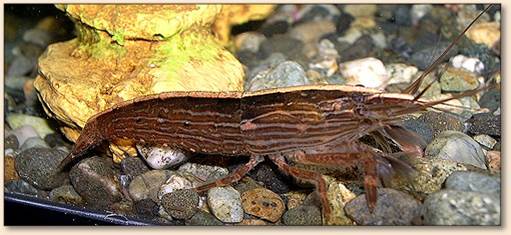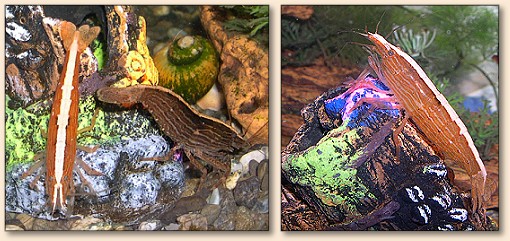- You are here:
- FAOL Home >>
- Articles >>
- Ladyfisher
 |
from Deanna Travis FlyAnglers Online Publisher & Owner |
IS YOUR FLY FISHING BORING?
| Sysadmin Note |
|---|
| From the archives (Jan 30th, 2006) |
One of the marvels of nature is that it is always changing and evolving. There are animals, plants, insects which are all still changing. In the grand scheme of things I suppose we are still evolving too. Maybe in some future generation we will have all the needed computer and tecky knowledge already 'built' in. Someone has already suggested a sort of mental cell-phone to be implanted at birth.
We have a small aquarium like many of you. Most of the inhabitants are the usual kinds of community fish, except for three freshwater shrimp. I had not seen them before, and they are rather fascinating. They are about three inches long and have a hard exterior shell. All are the same specie. But they are entirely different. The common name for them is Bamboo Shrimp. Two are brown, and one is orange. At least two of them have gone through a molt. All were brown/tan when we bought them.


As you can see, the colors are very different. And no, they don't change color to match what they are on.
In nature, insects are also different. A hatch which appears in one place in a stream can differ considerably from the same insect a half mile up or down stream. And not just in body color, but in size as well. The 'experts' vary on if they are not a sub-species, but for my point here, it is enough that they exist.
If you tie flies, this is where it gets interesting.
We do a Fly of the Week each week, along with Old Flies, and from time to time we add to our Atlantic Tying series as well. Each has the recipe for the fly shown. And as tiers, we do want to try to match the example as best we can. Certainly there is a reason to do that, we just may want to see if we can, or we want to produce the 'historical' flies because they are beautiful and present a challenge or we don't feel comfortable straying from the usual recipe. And at some point we all tie 'display flies' which we don't ever intend to fish.
But what about the flies we do fish?
If for example you are tying a Pale Morning Dun, does it really matter what color the body is? Maybe if the water you are fishing is very glass-like with no riffles, it could be the fish really is keying on the body color. Or maybe the fish is keying in on the silhouette? Or the height of the wings? Or the footprints in the meniscus?
Frankly, we don't really know. Sure we all make guesses, and a lot of theory too. But we really don't know.
So with that, I'll give you yet another theory to think about - and you can do something or maybe nothing with it. This is for dry flies.
The theory is that you don't need to tie fly bodies in special colors, nor the wings either. The fish, according to the theory, respond to size, light or dark, and silhouette. Therefore you should only need a few flies to cover all mayflies. A few to cover all caddis and just a few more for all stoneflies. It certainly would simplify one's fly box, plus cut down immensely on the number and varieties of fly tying materials one needs. It certainly would be cheaper.
I can honestly say I don't know of one fly fisher who has thoroughly tested the theory. The person who told us the theory is dead, and I don't think he tested it out either.
And there is a reason, I believe it hasn't been tested.
It's boring.
Other than tying colorless, uninteresting flies, the actual fishing of them would only give a person a 'well maybe' it works conclusion. What fun is that?
Isn't a great share of what we do in fly tying involved with trying out new flies (as if the fish were suddenly tired of what we and others have been floating past them.) Isn't that why we are always looking for a new pattern/recipe for this or that insect? Why we pour over fly tying catalogs? Why we search for some hard-to-get hair or feathers?
So part of the lure of fly tying is the acquisition of materials. And there's more. It's being able to tie a fly with those materials and catch a fish! And, yes to have the bragging rights as well.
The fact that there are differences in nature were also evident to the late Al Campbell who wrote all of our fly tying instruction here on FAOL. And he often encouraged the readers to collect their local bugs and look at the various colors - and then tie the flies to match what you have, not what the given 'recipe' calls for.
While the color may be more important to wet flies, it still makes sense to match what you have and not be a slave to what others may think you need to fish or tie.
And that is a lot more of a challenge than fishing light or dark, size or silhouette. And certainly more interesting for the tiers.
Then of course there is another theory, that of the 'impressionists' who believe fish never have a real true view of the fly anyway, so you can just tie pretty much a 'snapshot' of what you think the fish might see. Everything sort of blurred together as if the fly were in motion (which of course it is.)
There really are "different strokes for different folks." As long as you're having fun with it, tying or fishing, or just thinking about it, that is all that really matters.